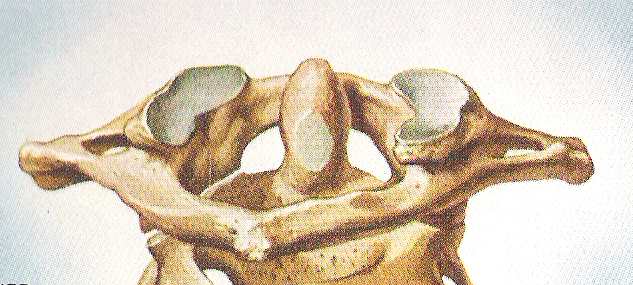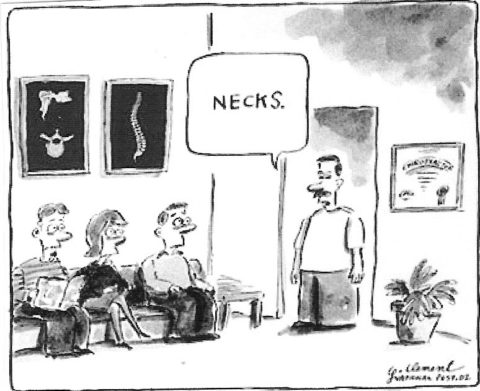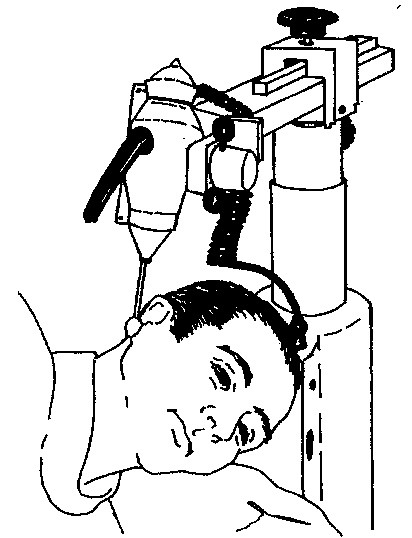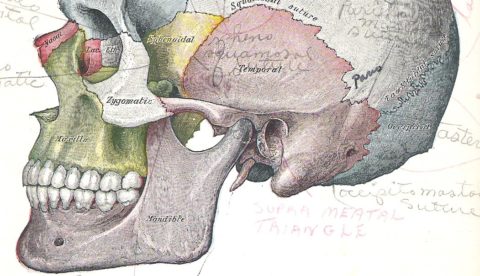
Preamble: My first article published on Science-Based Medicine, on August 7, 2009, “The Problem with Chiropractic NUCCA“, examined an adjustive technique used by chiropractors who believe that subluxation or misalignment of the atlas (1st cervical vertebra) is a major cause of disease. As a chiropractor who answers questions about chiropractic on the Chirobase web site, I often receive letters from patients who have doubts about the validity of a treatment which requires that every patient have an atlas adjustment for whatever problem the patient might have, including low-back pain.
In 2007, a medical journal published a pilot blood pressure study which concluded that NUCCA (National Upper Cervical Chiropractic Association) upper cervical adjustments to realign the atlas would lower blood pressure in persons with Stage 1 hypertension. The article was widely quoted by chiropractors as proof that upper cervical manipulation was an effective treatment for high blood pressure. In 2016, however, a duplication of the NUCCA study, done at the Palmer College of Chiropractic, concluded that upper cervical manipulation did not lower systolic or diastolic blood pressure. The study was largely ignored by subluxation-based chiropractors who continue to quote the findings of the 2007 study to support use of upper cervical manipulation as a treatment for high blood pressure and a variety of other health problems.
Following is an update of my 2009 NUCCA article.
From HIO to NUCCA
In the early 1930s, after nearly three decades of teaching that subluxations anywhere in the spine can cause disease, B.J. Palmer, the developer of chiropractic, announced that he had found the one and only cause of disease: subluxation of the atlas, the vertebra at the top of the spine (C1). Palmer concluded that subluxation of a vertebra below the axis (C2) was not possible because vertebrae below that level were bound together by intervertebral discs and interlocking joints. Students at the Palmer School of Chiropractic, the “Fountain Head of Chiropractic”, were not permitted to adjust the spine below the axis until 1949 when full-spine techniques were once again included in the course of instruction.
B.J. Palmer’s “hole-in-one” (HIO) technique for adjusting the atlas and the axis is still being used by some chiropractors, many of whom are members of the National Upper Cervical Chiropractic Association (NUCCA). According to the 2005 edition of Job Analysis of Chiropractic, published by the National Board of Chiropractic Examines (NBCE), 25.7% of practicing chiropractors include the “Palmer upper cervical/HIO” technique in their adjustive procedures. The 2010 edition and the 2015 edition of Practice Analysis of Chiropractic excluded mention of upper cervical chiropractic and other subluxation-based adjustive procedures that “place chiropractic in an unfavorable light.” But the NBCE continues to report that “The specific function of chiropractic practice is known as the chiropractic subluxation or joint dysfunction”.
The National Upper Cervical NUCCA Club
As noted above, in 2005, 25.7% of practicing chiropractors included use of upper cervical techniques in their treatment of patients. The National Upper Cervical Chiropractic Association Directory currently lists about 243 NUCCA chiropractors, 21 of whom are “board certified”.
Members of the National Upper Cervical Chiropractic Association specialize in adjustment of the atlas vertebra, using the procedure as a primary treatment for a great variety of ailments:
The focus of the NUCCA work is the relationship between the upper cervical spine (neck) and its influence on the central nervous system and brain stem function. It is this relationship that affects every aspect of human function from the feeling sensations in your fingers to regulating hormones, controlling movement, and providing the ability to hear, see, think, and breathe.
The mission of NUCCA is defined as “Maximizing the human health potential as associated with the reduction of the Atlas Subluxation Complex (ASC)”.
With such a broad and inclusive definition, a NUCCA practitioner may adjust the atlas as a treatment for ailments ranging from bed wetting and attention deficit disorder to multiple sclerosis and cerebral palsy.

NUCCA procedures
In an effort to locate “minor pain-free atlas subluxations” that allegedly cause brainstem ischemia and compromise brainstem neural pathways, NUCCA practitioners commonly use these procedures:
- A supine leg-length check that reveals disparities in leg length when the head is turned left or right.
- Use of thermography or infrared thermocouple devices to measure skin temperature over the cervical spine.
- A postural analysis using the “NUCCA Anatometer” that requires standing on a platform apparatus that measures postural imbalance, pelvic distortion, head tilt, and unequal right and left leg weight bearing.
- Three x-ray views of the atlas-axis area.
- Use of a protractor to measure atlas alignment.
The patient is then placed in a side-posture position (lying down) so that the heel of the hand (pisiform bone) or a machine stylus can be used to adjust the “misaligned” atlas.

An electrically powered stylus used to adjust the atlas vertebra.
A follow-up of the NUCCA blood pressure study
In 2007, the Journal of Human Hypertension, a Nature Publishing Group medical journal, published an 8-week pilot study which concluded that early high blood pressure could be reduced by using a NUCCA adjustment to correct a minor pain-free atlas misalignment that can “potentially injure, impair, compress and/or compromise brain stem neural pathways”. The study was widely distributed by NUCCA chiropractors who promoted use of upper cervical manipulation as a treatment to reduce high blood pressure and to “maximize the human health potential”. A multi-disciplinary follow-up study of the effect of upper cervical manipulation on Stage 1 hypertension, published in 2016, was done at the Palmer College of Chiropractic under a grant awarded by the National Center for Complementary and Alternative Medicine. The study concluded that:
Six weeks of toggle recoil spinal manipulation did not lower systolic or diastolic blood pressure when compared with a sham approach.
Participants in the NUCCA study received no hypertensive medication whereas participants in the Palmer study remained on their antihypertensive medications.
A toggle recoil adjustment to realign the atlas, similar to that used in the NUCCA study, was used in the Palmer study. The adjustment is done by using the pisiform bone of one hand to apply a speedy thrust (with equally speedy withdrawal) to one side of the neck (atlas) while the patient is in a side posture.

A toggle recoil adjustment using a pisiform contact on the atlas vertebra.
Views and opinions of a skeptic
Pre-hypertension or Stage 1 hypertension, determined by systolic blood pressures between 130 and 139 mm Hg and diastolic pressures between 80 and 89 mm Hg, is usually treated with lifestyle modifications. Pre-hypertension blood pressures may fluctuate, depending largely upon whether the cause of the hypertension is secondary or primary, making it difficult to evaluate the effect of treatment.
Investigating claims that chiropractic manipulation can lower blood pressure, a study examining the effect of diversified spinal manipulation, published in a 2002 issue of Journal of Hypertension, concluded:
For patients with high normal blood pressure or Stage 1 hypertension, chiropractic spinal manipulation in conjunction with a dietary modification program offered no advantage in lowering either diastolic or systolic blood pressure compared to diet alone.
I have never been convinced that manual therapy of any kind can produce a permanent reduction in blood pressure. Relaxation or muscle-tension relief that occurs as a result of manual therapy may temporarily lower some secondary forms of pre-hypertension, but there is no reason to believe that an upper cervical adjustment ─ or any spinal adjustment ─ can permanently reduce high blood pressure, which has many primary causes unrelated to the neck or the spine.
When I was in chiropractic school back in the early 1950s, I learned from Best & Taylor’s Physiological Basis of Medical Practice that compression of the carotid sinus at its bifurcation in the upper cervical area would cause a fall in blood pressure and heart rate by raising the pressure in the sinus, while pressure on the common carotid artery in the lower cervical area would raise arterial pressure and heart rate by reducing pressure within the carotid sinus. Such effects resulting from manual stimulation of the neck are temporary and have not been shown to be a cure for essential hypertension or for high blood pressure caused by bad kidneys, diseased arteries, and other primary causes.
Whatever effect neck manipulation might have on blood pressure, the claim by chiropractic upper cervical specialists that they can lower blood pressure by correcting minor misalignments of the atlas to relieve “brain stem ischemia” and to normalize brain stem neural pathways is physiologically implausible. Without serious injury to upper cervical ligaments, an atlas misalignment would not move far enough to affect the brain stem or compromise blood flow in the vertebral arteries.
It is well known that the vertebral arteries can be stretched and possibly injured when manipulation forces passive rotation of the atlas past 45 or 50 degrees. A NUCCA adjustment does not involve rotation of the upper cervical spine, but thrusting on the atlas might fracture the styloid process (a slender projection of bone on each side of the base of the skull) and threaten an internal carotid artery where it enters the carotid canal in the base of the skull.

A styloid process lies in the path of a NUCCA thrust on the atlas vertebra.
Atlas alignment
When the atlas is freely movable and is not locked by disease or injury, its resting place is determined by the anatomical configuration of the articulating surfaces of the occiput, the atlas, and the axis and cannot be changed. The atlas might appear to be misaligned on x-ray measurements simply because of structural deviations from normal. No matter how many times a painless freely movable “misaligned” atlas is adjusted, it always returns to its anatomically dictated resting place. I have heard many stories of patients who keep going back to their chiropractor for repeated adjustments to realign the atlas when symptoms persisted, requiring another adjustment because the last adjustment “did not hold.” And despite repeated adjustment of the atlas, the atlas is always “out of alignment” when symptoms are present or when a new health problem develops. Fear that an atlas misalignment might be a cause of disease has a powerful nocebo effect that keeps patients coming back for “maintenance therapy”.
Even when there is atlanto-occipital fixation or atlanto-axial fixation (a rare occurrence which might benefit from manipulation), there is no evidence to suggest that the brain stem would be affected if serious injury has not occurred or if there is no upper cervical disease or anatomical deformity. In a NUCCA case, a freely movable atlas might be repeatedly manipulated to correct an “atlas subluxation complex” as determined simply by checking pelvic imbalance and leg-length disparity. According to the 2007 NUCCA blood pressure study, “What is clear is that misalignment of the Atlas vertebra can be determined by assessment of the alignment of the pelvic crests”.
Atlas displacement that occurs as the result of a real orthopedic subluxation (a partial dislocation) is a painful and serious problem that may truly threaten the brain stem and should not be subjected to chiropractic manipulation. If slight misalignment of the atlas could compress the brain stem, thrusting on the side of the neck with an upper cervical adjustment, forcing excessive movement of the atlas, would be a dangerous practice.
In my 43 years of practice as a chiropractor, I was never able to determine that manipulation of the spine ever permanently changed the position of the atlas or any other vertebra that is freely movable or that restoration of mobility in a fixated vertebral joint had an effect on general health.
Scientific objectivity vs. indoctrinated bias
In view of the fact that the 2016 Palmer blood pressure study did not support the findings of the 2007 NUCCA study, the question arises about the reliability of the findings of the NUCCA practitioner who examined the patients and then provided sham intervention to one group and real treatment to another group. He alone examined and treated the patients who participated in the study. Atlas misalignment was determined by using such operator-dependent assessments as measuring leg length. A NUCCA “Anatometer” was used to measure “postural asymmetries”. X-ray measurements of the atlas, guided by the beliefs of the subluxation-based chiropractic examiner, might have been influenced by structural irregularity or by patient positioning.
The chiropractor who participated in the NUCCA study has stated that the atlas vertebra is the “fuse box to the body”, and that if the atlas gets locked in a position as little as half a millimeter (half of .03937 inch) out of line, it can “pinch the base of the brain”.
With about 50% of cervical rotation normally occurring in the atlantoaxial joints, it is unlikely that a slightly misaligned atlas would affect the brain stem. If the brain stem and its associated structures were that vulnerable, the human species would not have survived the evolutionary process. Injury of the medulla (lower) portion of the brain stem (at the atlas level), usually the result of fracture or dislocation of the atlas, can result in respiratory failure and possible death. A spinal cord injury at or above the 4th cervical vertebra, shutting down brain impulses to spinal nerves, can result in quadriplegia, but the body’s organs continue to function, supplied by autonomic nerve ganglia and plexuses located outside the spinal column.
A slight asymptomatic atlas misalignment (often a measured structural asymmetry), commonly identified by subluxation-based chiropractors as a subluxation, has not been proven to be significant. The claim by NUCCA practitioners that a slightly misaligned atlas is a cause of high blood pressure does not have enough supporting evidence to warrant the risk of manipulating the upper neck of patients suffering from high blood pressure, risking stroke caused by injury to vertebrobasilar arteries.
Although the NUCCA blood pressure study did note that “The mechanism as to why this improvement in BP occurs is unknown and cannot be determined by this study,” the methods used in the study are used by upper cervical chiropractors to locate and correct atlas misalignment claimed to be a major cause of disease.
Upper cervical chiropractic is only one of many unstandardized chiropractic techniques used by subluxation-based chiropractors to remove nerve interference by correcting vertebral subluxations so that the body can “heal itself.” Most chiropractic techniques are based on the Meric system, which assigns certain vertebrae to certain organs, despite the fact that spinal nerves supply musculoskeletal structures, not organs. The NUCCA technique is unique in that it focuses on one vertebra ─ the atlas. There is no credible evidence to suggest that an asymptomatic chiropractic subluxation complex, a vertebral misalignment, a real orthopedic subluxation, or a segmental dysfunction anywhere in the spine is a cause of organic disease.
Generic spinal manipulation can be helpful in treating mechanical-type neck and back pain and related problems. But such treatment is not the same as subluxation-based chiropractic adjustments used to treat a broad scope of health problems.

